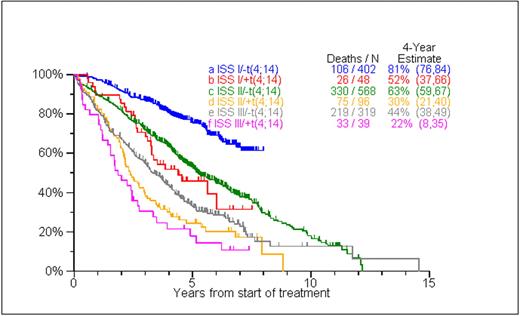Abstract
Abstract 743
There has been considerable recent focus upon the molecular classification of myeloma. However, the prognostic impact of molecular changes has mostly been assessed from small and/or incomplete studies from single institutions or groups. There has been no large scale analysis of molecular features linked to ISS stage.
In order to clarify the overall impact of molecular changes we undertook a collective analysis of 9,897 patients through the International Myeloma Working Group (IMWG). Within this population 2,295 patients had presence of cytogenetic abnormalities (Any CA); 1,713 hypodiploidy; 1,673 hyperdiploidy; 2,309 cytogenetic deletion 13; 3,226 deletion 13 by FISH; 1,573 FISH t(4;14); 1,486 FISH del p17; 1, 683 FISH t(11:14); and 366 FISH t(4;16). Enrolled patients had complete clinical and treatment details available including baseline standard prognostic factors, ISS stage, as well as both progression free survival (PFS) and overall survival (OS) information. Data came from 14 sites: 3 from the US and the remainder from Europe, Asia, and Latin America as for the ISS staging system analyses. Univariate and multivariate analyses were performed.
Each of the known adverse molecular features had a negative impact upon both PFS and OS (p=002 - <0.0001). Among the deleterious FISH abnormalities the t(4;14) abnormality was the most highly correlated with poorer outcomes by PFS: 4 year estimate: 32% vs. 60% (p<0.0001). The t(4;14) abnormality combined with ISS Stage also significantly enhanced predictive capability: ISS Stage I without t(4;14) OS 81% @ 4 years; ISS Stage III with t(4;14) OS 22% @ 4 years (P<0.0001) [Figure 1]. The best outcomes were for ISS Stage I in the presence of t(11;14): OS 89% @ 4 years. Absence of any one adverse feature correlated with 80-81% OS @ 4 years for Stage I. Presence of any one adverse feature had a more variable impact and correlated with 22%-40% OS at 4 years for Stage III.
In univariate correlations the most predictive correlations with OS were presence of Any CA, t(4;14), 17p-, hypodiploidy, cytogenetic 13q- with R2 values of 6.9%, 4.5%, 4.1% and 3.8% respectively. In multivariate analyses, ISS stage provided the best predictions: R2 values = 13.3%. The added contributions from molecular features were: t(4;14) 3.8%; cytogenetic 13q- 2.9%; Any CA 2.3%; and 17p- 1.0%. The maximum total R2 for OS was 22%.
This large multicenter analysis confirms the correlations between abnormal molecular findings and outcomes. Combinations with ISS Stage provide the best predictive capability. Presence of Any CA, t(4;14), 17p-, hypodiploidy and cytogenetic 13q- contribute to poorer outcomes by ISS stage. The presence of hyperdiploidy and/or t(11;14) contribute to better outcomes. There is thus validation of prior molecular studies related to prognosis utilizing this large IMWG database.
No relevant conflicts of interest to declare.
Author notes
Asterisk with author names denotes non-ASH members.


This feature is available to Subscribers Only
Sign In or Create an Account Close Modal